Prayer, reverence, and music marked the Feast Day of Our Lady of Guadalupe, Patroness of the Americas, throughout the Diocese of Venice.
Celebrated on Dec. 12, the Feast is often linked to the Dec. 9 Feast of St. Juan Diego, the day in 1531 when Our Lady first appeared to the saint near modern day Mexico City.
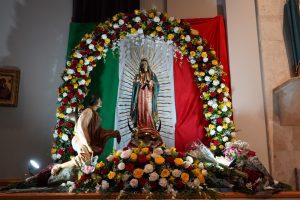
Our Lady of Guadalupe Feast Day celebrations are a longstanding tradition in the Diocese of Venice. In addition to celebrating this special day with the Holy Sacrifice of the Mass, there were a variety of other events, including overnight vigils, large processions, early morning prayer, as well as outdoor festivities. Many of these celebrations included a variety of dancers dressed in elaborate costumes or traditional garb.
“Our Lady of Guadalupe means so much to me and my family,” said Maria Lopez of St. Paul Parish in Arcadia after Mass on Dec. 8, 2024. “It is a devotion I grew up with and learned about from my grandparents and parents. We all pray to the Blessed Virgin when there is an illness in the family or we need guidance in our lives. Our Lady of Guadalupe gives me great comfort.”
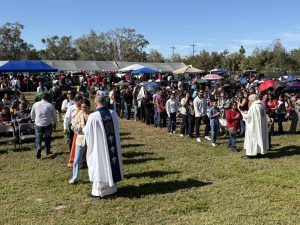
Bishop Frank J. Dewane celebrated Mass in a field at St. Paul Parish in Arcadia. The Mass was celebrated ahead of the Feast Day to accommodate the maximum number of families. As a result, more than 1,500 took part.
A festival followed the Mass with a wide variety of food as well as dancers. Many of the young girls were dressed as Our Lady, while the young boys dressed as St. Juan Diego, the peasant who saw the apparitions of Our Lady in Mexico City.
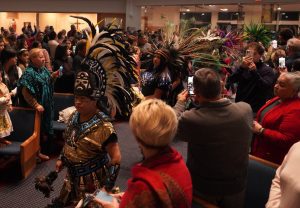
A large gathering of the faithful from St. Michael Parish in Wauchula and Holy Child Mission in Bowling Green also took place on Dec. 8 at Pioneer Park in Zolfo Springs. The Mass was in three languages, Spanish, English, and Creole, representing the diversity of the Parish. Before Mass, a procession with a statue of Our Lady followed by children carrying flowers led to the park pavilion. A cultural celebration followed.
For the first time, St. Charles Borromeo Parish in Port Charlotte held its own community-wide celebration of Our Lady on Dec. 8, highlighted by a procession around the Parish grounds and a wide variety of food and music.
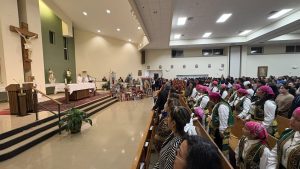
Many Parishes held vigils, some lasting until dawn. These included a retelling of the story of Our Lady of Guadalupe, mariachi bands, the singing of songs to Our Lady as well as prayer and contemplation before the image of Our Lady.
At St. Jude Parish in Sarasota, Aztec dancers led the opening processing with a standing-room-only Mass beginning at 11 p.m. on Dec. 11. Father Jiobani Batista, Pastor of St. Jude, told the faithful that honoring Our Lady and following her example is a pathway to growing closer to Her Son, Jesus Christ.
Meanwhile, at Holy Cross Parish in Palmetto, hundreds gathered before dawn to hear a mariachi band serenaded Our Lady prior to a Mass which lasted until sunrise.
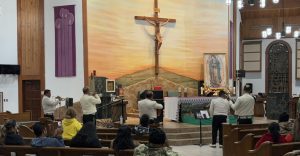
The celebration at St. Peter the Apostles Parish in Naples took place on Dec. 12, when nearly 100 dancers led a procession around the Parish grounds and into the church for Mass. Carlos Martinez said the Feast Day is an important one for people with Mexican heritage. “The Blessed Virgin Mary embraced us with open arms. What an important moment that deserves our thanks and a true celebration.”
It was in 1531 when Our Lady of Guadalupe appeared, dressed like an Aztec princess, to St. Juan Diego, a poor widower who was on his way to Mass. She asked, in his native language, to have the Bishop of Mexico build a church in Her honor. Skeptical, after a second visit, the Bishop asked for a sign. The Blessed Mother instructed St. Juan Diego to climb to the top of Tepeyac Hill where he would find flowers to pick and place in his tilma, a garment made from cactus. St. Juan Diego gathered the dark pink roses into his cloak with the help of the Blessed Mother.
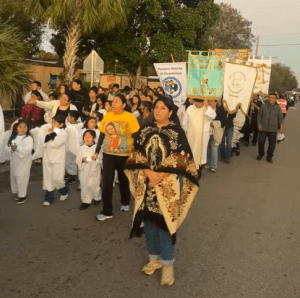
For a third time, St. Juan Diego was ushered in to see the Bishop with a sign that the apparitions were real – Castilian roses. That alone was a miraculous sign since these roses were not from that region and did not grow in winter, but were in fact from Castile, Spain, the hometown of the Bishop. St. Juan Diego did not realize – until after he opened his cloak letting the roses tumble out – that an image of Our Blessed Mother was emblazoned on his tilma.
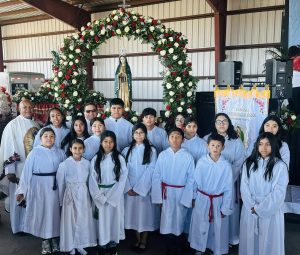
This apparition led to the conversion of Mexico almost overnight, with nine million Mexicans baptized into the Catholic Church within a decade, when up to that time Catholic missionaries from Europe had made very little headway. The Basilica of Our Lady of Guadalupe in Mexico City was built on the site of the apparitions and is one of the most visited religious shrines in the world. It is also home of the actual tilma of St. Juan Diego, which can still be seen, with the image clearly visible, nearly 500 years later.
Our Lady of Guadalupe was first declared “Patroness of the Americas” by Pope Pius XII in 1946, a title reaffirmed by St. John Paul II in 1999.
